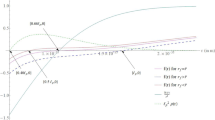Abstract
A recent idea, put forward by Mund, Rehren and Schroer, is discussed; it suggests that in gauge quantum field theory, one can replace the point-localized gauge fields by string-localized vector potentials built from gauge-invariant observables and a principle of string independence. Based on a kinematical model, describing unmovable (static) fields carrying opposite charges, it is shown that these string-localized potentials cannot be used for the description of the gauge bridges between electrically charged fields. These bridges are needed in order to ensure the validity of Gauss’s law. This observation does not preclude the existence of Poincaré invariant theories, describing the coupling of string-localized gauge-invariant potentials to matter fields. But these potentials are not a full-fledged substitute for the gauge fields in “usual” quantum electrodynamics.
Similar content being viewed by others
References
Brandt, R.A.: Field equations in quantum electrodynamics. Fortschr. Phys. 18, 249–283 (1970)
Löffelholz, J., Morchio, G., Strocchi, F.: Mathematical structure of the temporal gauge in quantum electrodynamics. J. Math. Phys. 44, 5095–5107 (2003)
Mund, J.: String-localized quantum fields, modular localization, and gauge theories. In: Sidoravičius, V. (ed.) New Trends in Mathematical Physics, pp. 495–508. Springer, Berlin (2009)
Mund, J., Rehren, K.-H., Schroer, B.: Relations between positivity, localization and degrees of freedom: the Weinberg–Witten theorem and the van Dam–Veltman–Zakharov discontinuity. Phys. Lett. B 773, 625–631 (2017)
Schroer, B.: An alternative to the gauge theoretic setting. Found. Phys. 41, 1543–1568 (2011)
Steinmann, O.: Perturbative Quantum Electrodynamics and Axiomatic Field Theory. Springer, Berlin (2000)
Acknowledgements
DB gratefully acknowledges the hospitality and support extended to him by Roberto Longo and the University of Rome “Tor Vergata,” which made this collaboration possible. FC and GR are supported by the ERC Advanced Grant 669240 QUEST “Quantum Algebraic Structures and Models.” EV is supported in part by OPAL “Consolidate the Foundations.” All authors acknowledge support by the MIUR Excellence Department Project, awarded to the Department of Mathematics, University of Rome Tor Vergata, CUP E83C18000100006.
Author information
Authors and Affiliations
Corresponding author
Additional information
Publisher's Note
Springer Nature remains neutral with regard to jurisdictional claims in published maps and institutional affiliations.
Rights and permissions
About this article
Cite this article
Buchholz, D., Ciolli, F., Ruzzi, G. et al. On string-localized potentials and gauge fields. Lett Math Phys 109, 2601–2610 (2019). https://doi.org/10.1007/s11005-019-01203-w
Received:
Revised:
Accepted:
Published:
Issue Date:
DOI: https://doi.org/10.1007/s11005-019-01203-w




